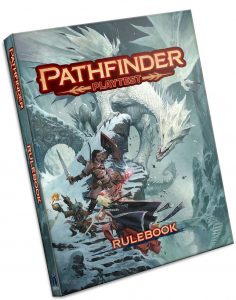The playtest for Pathfinder 2nd edition is now live. Not surprisingly, nerds have questions. Luckily, Erik Mona–Publisher at Paizo–ushered me and Davery into a secret chamber where we sat around a table and talked shop.
While the audio didn’t survive the experience, we transcribed the conversation and have posted it below, edited slightly for clarity.
Pathfinder 2 Playtest: What Makes Pathfinder Pathfinder
Davery: Is there one or two things that you guys have used specifically, that you guys are like, “This is how you know it’s specifically Pathfinder.”
Erik: Let me answer the question broadly, and that is to say, no matter what edition you’re talking about, these things are important to Pathfinder. And one that I would say, that I’ve sort of mentioned before, is maximum customization of your character concept to match the vision of the hero in your head. That’s Pathfinder.
The rules shouldn’t be getting in the way of saying, “Well, I want to make a wizard who fights with a battle ax,” right? It might not be the most effective character in the world, but you should be able to figure out a way to make that character and through feat choices and magic weapons, make that character as effective as you want him to be, within reason, right? I mean, it’s a wizard, not a fighter, right?

But the rules shouldn’t get in the way of that. A second thing that is really important to Pathfinder as an identity is that it is a game that has a tactical element. It’s not just a storytelling. It’s a game that’s played on a grid with miniatures. You have to pay attention to where people are standing. There are areas of effect. I mean, it’s a game. It’s not just some activity, right?
I think that those are two hallmarks of it, the broad ones. And here’s one of the specific things that I hope really does stick in the new Pathfinder, is we’ve changed the action economy of the game, so instead of having seven different types of actions, and you get to move and do an action or maybe full-round action or maybe you do a full-round action plus a swift action or, how many swift actions do you get? You just get three actions, and everything is pretty much an action, and some interesting things are more than one action.
You have three actions a round. That might be move, move, and attack. That might be attack, attack, move. That might be attack three times. Not every one of those attacks is going to be at the same attack bonus, but you can do that if you want.
Or you can do other interesting things, like you can say, “I’m gonna cast a Magic Missile,” and that’s one action, so you can move twice and cast Magic Missile. Or you could move once and spend a verbal action and a somatic action, and now you can shoot two Missiles. Or you could stand still and use a verbal, somatic and material component, and now you can shoot three missiles.
Or the same thing is true with Heal, so as a player, if I’m just going to use one action, I can reach out to Clave and I can touch him and he is healed. Or, I can spend two actions and I can heal from a distance, I no longer have to touch him. Or, I could spend all three of my actions that turn and it’s sort of a traditional healing verse.
Clave: I prefer that. I don’t like to be touched as a general rule.
Erik [laughs]: By changing the action economy, we’ve made the game simpler for people to understand, “Oh, I can do three things per turn,” but by doing all these little nuances, “Oh, but if you spend two of those actions doing this, then it makes it a little bit better” or whatever, it adds sort of a more interested flexibility to it.
So, I hope that, if I’m answering this question a year from now and after the play test has gone through, that I can say that the three-action economy is a key part of Pathfinder. And a better way of saying that maybe is that you learn a simple thing, and then you find interesting and complex ways to implement that.
Davery: Yeah. From what you were saying there, the verbal, the verbal and somatic, the verbal, somatic and material… it sounds like, and I kind of just thumbed through the book last night… it sounds like you’re going deeper rather than broader?
Erik: Yeah, I think in some ways, that’s true, because also, it’s not like we’re just going to stop publishing with the core rule book. We’ll do more character classes; we’ll do more stuff. So, there’s a lot of room for that broadness, like in different types of characters and different types of things, but we do want to go deeper. I think that’s true.
Davery: I’ve been saying about the archetypes, “Oh, there’s a huge opportunity for expanding them…”

Erik: Absolutely, and we’ve made–at least in the playtest version right now–we’ve made multi-classing kind of based on an archetype sort of a system. And one of the things that’s really interesting too, and let me go back to the components thing for a second, since components were added to fantasy gaming in the ’80s if not before, they’re just little letters. They don’t really mean anything. Maybe if it’s a M, it means you have to pay some cash to cast that spell. But whether it’s a verbal or whatever, maybe in some cases you’re gagged so you can’t do a spell with a verbal component. Rarely, when you cast Magic Missile does it come into play what the components of the spell are.
But if you’re having to kind of go through and say, “All right. I want to shoot two missiles, so I’m going to use a verbal and I’m going to use a somatic component,” you’re all of a sudden starting to visualize what your character’s actually doing. That can enhance storytelling.
And I think that’s very interesting. Another thing that we’ve done with the 2nd Edition–and it’s something that because this game has been out for two-and-a-half days, we’re getting a lot of hot takes–people are saying, “I just looked through it!”, and one of the things that I think people are starting to realize, and that I even struggled with a little bit the first time I was seeing early draft versions, is a lot of stuff is feats. A lot of things that didn’t used to be feats are feats, class features, or class feats. We have ancestry feats, which are like racial feats that we used to have. There are general feats, there are just lots of different kinds of feats, and not each kind of feat is perfectly balanced against all feats, there are different types of feats.
In 1st Edition Pathfinder, you’re a first-level fighter, and you could pick a feat that is about making you a more elfy, as an elf, or you could pick Power Attack. You’re gonna pick Power Attack every. Single. Time. OK, maybe you’re not, but it takes a rare player to say, “Here’s this thing that makes me inherently better at fighting, which is what I’m what supposed to do, and here is thing that gives me a social bonus when I’m talking to elven nobles.” I’m gonna pick the thing that gives me a bonus on every time I swing my sword!
But because we’ve broken those things off, and at certain levels you choose an ancestry feat, it really gives you the opportunity. You get many more feats over the course of your career, because like I said, many many things are now feats, so it gives you the chance to kind of explore different aspects of your character without you having to choose something that’s disadvantageous.
I think that’s a real advantage. But on first glance, you might think, “Wait, I don’t… some of the feats don’t look balanced with each other!” Well, that’s by design.
Clave: Right, and then when you play into your character a little bit…
Erik: Exactly: The feats within their types should be balanced against each other, but the feats also have levels, so even then, they’re not necessarily balanced against each other. It’s a new world, and it’s gonna be interesting to see how people react during the playtest.
Clave [looks to Davery]: I haven’t heard a single person not like the action system. You?
Davery [shakes head]
Erik: Especially people who have played it!
There is more:
Click here for Part 1: Erik Mona on Why You Should Give the Playtest a Try and for
Part 3: Erik Mona on What Makes Paizo Paizo and

